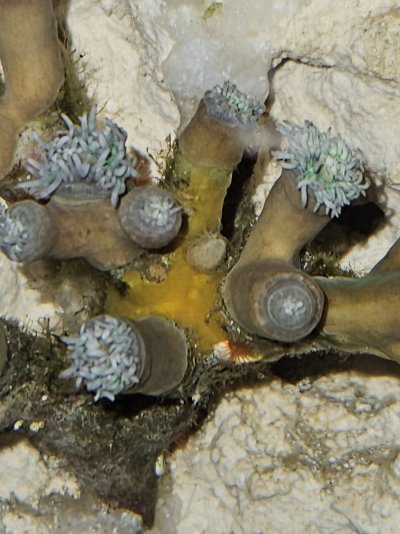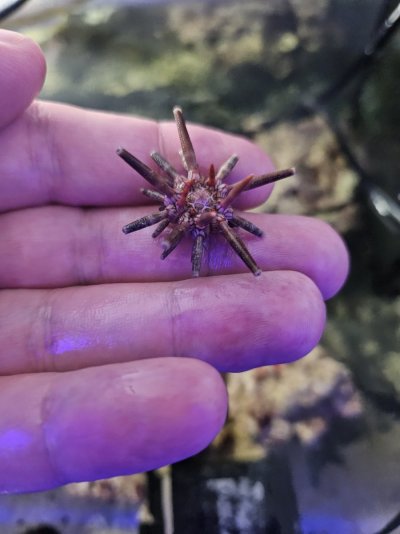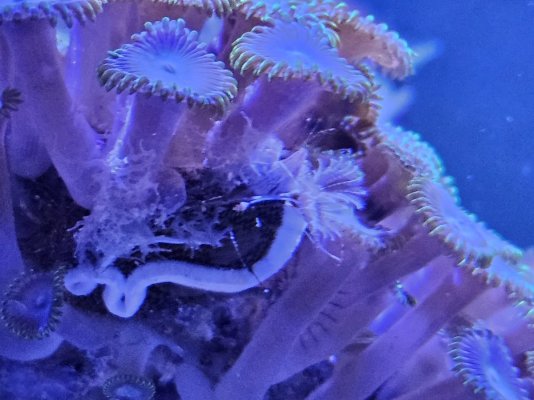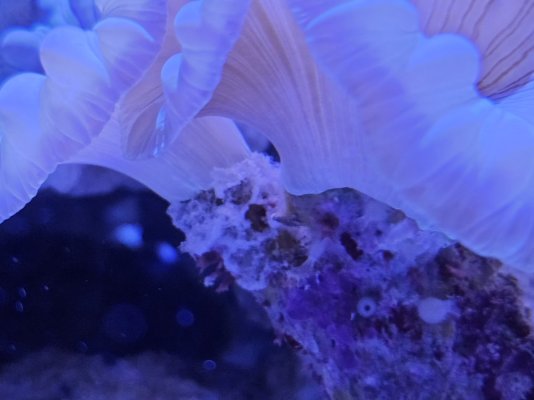Navigation
Install the app
How to install the app on iOS
Follow along with the video below to see how to install our site as a web app on your home screen.
Note: This feature may not be available in some browsers.
More options
You are using an out of date browser. It may not display this or other websites correctly.
You should upgrade or use an alternative browser.
You should upgrade or use an alternative browser.
What will eat sponge?
- Thread starter Reefkeepers Archive
- Start date
- Tagged users None
- Joined
- Apr 20, 2019
- Messages
- 14,354
- Reaction score
- 22,034
Some fish eat sponge but it's completely hit or miss because of the wide variety of sponges and individual tastes of fish. Manual removal is most effective.
I think Moorish Idols and Some Angelfish do, but I wouldn't consider that a solution to clean up a pest as that animal will need that food in the future to survive.
What types of sponges do you have? What size aquriam and how oldAny reef safe fish/invert that will eat sponge? I desperately need to eradicate most sponge from my system. Also, will pyramid butterflies eat sponge?
120 gallon, 9 months, pineapple, orange encrusters and some white, fluffy sponge that I haven't ID'dWhat types of sponges do you have? What size aquriam and how old
It's a tough one as your aquarium is quite large.120 gallon, 9 months, pineapple, orange encrusters and some white, fluffy sponge that I haven't ID'd
My aquriam that suffers from sponges, I have basically rip cleaned, anything that shows sign of a sponge I have cleaned outside of my aquriam. I honestly do not of of any livestock that could help.
Not to mention they would also eat my LPSI think Moorish Idols and Some Angelfish do, but I wouldn't consider that a solution to clean up a pest as that animal will need that food in the future to survive.
To my knowledge sponges are fueled by silicates. I found that my TDS meter doesn't detect these from my RODI well. having a look at replacing your DI Resin may help but if you reduce their input it may help a lot more than something to consume them.
That's weird. Haven't done a water change in over 4 months, only water getting added to my system is the ATOTo my knowledge sponges are fueled by silicates. I found that my TDS meter doesn't detect these from my RODI well. having a look at replacing your DI Resin may help but if you reduce their input it may help a lot more than something to consume them.
Edit: just realized that there is a spaghetti worm that always drops a pile of very fine sand in the current.
Lots of things will eat sponges, but I don’t know if any of them (that won’t starve like nudibranchs would) are totally reef-safe - almost anything that might eat sponges are a risk to corals too (and, in some cases, inverts as well). Beyond that, not every sponge eating critter will eat every sponge, so there’s no guarantee any critter you get would eat the sponges you want them to.
To quote another of my posts:
Manual removal is almost certainly your best option here (for why, see the first quote below, for manual removal control ideas, see the other two):
-Angelfish (particularly large angels, from what I’ve seen)
-The pencil urchin Eucidaris tribuloides*
-Starfish (quite a few different species eat sponges, but not all of them do; aside from Aquilonastra starfish - known in the hobby as Asterina starfish - starfish have abysmal survival rates past ~8-13 months, so I’d suggest to avoid these)
-Moorish Idols (these have abysmal survival rates pretty much regardless of how long they’ve been in captivity, so I can’t recommend them either)
-Nudibranchs (they only eat like 1 to 4 specific species of sponge total, and they will not branch out beyond those species - please do not buy these, they will starve)
-Some trunkfish and (typically large) filefish reportedly eat sponges (and inverts)
I’m sure there are some other species I’ve missed (particularly fish species), but that pretty well covers the known sponge eaters.
*Info on the pencil urchin diet:

To quote another of my posts:
Manual removal is almost certainly your best option here (for why, see the first quote below, for manual removal control ideas, see the other two):
Just to put this out there - the problem with using biological controls (i.e. something that eats it) with sponges is that there are a ton of different sponges, some of which look indistinguishable from others. Some of these sponges are inedible or extremely undesirable foods to some species (either because of chemical defenses* or just because of taste preferences) while being highly desirable to other species. So, even if you pull in a known sponge-eating species of fish/starfish/whatever, there's no guarantee it will eat the sponge you want it to eat. Also, many of these sponge-eating species eat other things (like coral) that you might not want them eating.
Long story short, manual removal is probably your best option for sponges until more study has been on both specific sponges and specific sponge-eaters, but you can try it if you want.
*Just as a note on the chemical defenses of sponges, many sponges produce chemicals to avoid being eaten. Some of these chemicals are more generalized, some of them are specifically anti-fish, some are specifically anti-echinoderm (starfish, urchin, etc.), etc. So, again, some things might eat one sponge but not another, and because of the whole indistinguishable thing mentioned above, the sponges that are and are not being eaten may look pretty much identical (some may be distinguished/ID'ed under microscopic investigation, others may need to be DNA tested to be distinguished/ID'ed).
Just my two cents here.
The best way I've heard to control sponge growth at this point is to use a steel straw to scrape and siphon out the sponge you want to remove. Sometimes you can create bad conditions for them and kill them off that way, but that's typically much harder and not always effective.
Some other sponge removal methods:
Other suggestions include exposing the sponge to air (obviously not a guaranteed solution, and definitely not viable for this situation); hydrogen peroxide dipping the sponge (again, not viable here); injecting the sponge with hydrogen peroxide, vinegar, boiling water, or air; microbubbles in the display; and a few more. Predation is not usually a good solution for this issue
All of that said, if you’re really determined to try biological controls (i.e. predation) for your sponges, here are some known sponge eaters you might be able to find in the hobby:Basically, if the sponges have enough food and enough trace elements (which for most sponges includes silicates) to meet their needs, then you’ll see their populations booming.
If you can figure out what’s allowing them to thrive in your tank, then you can deal with that root cause and get rid of them.
-Angelfish (particularly large angels, from what I’ve seen)
-The pencil urchin Eucidaris tribuloides*
-Starfish (quite a few different species eat sponges, but not all of them do; aside from Aquilonastra starfish - known in the hobby as Asterina starfish - starfish have abysmal survival rates past ~8-13 months, so I’d suggest to avoid these)
-Moorish Idols (these have abysmal survival rates pretty much regardless of how long they’ve been in captivity, so I can’t recommend them either)
-Nudibranchs (they only eat like 1 to 4 specific species of sponge total, and they will not branch out beyond those species - please do not buy these, they will starve)
-Some trunkfish and (typically large) filefish reportedly eat sponges (and inverts)
I’m sure there are some other species I’ve missed (particularly fish species), but that pretty well covers the known sponge eaters.
*Info on the pencil urchin diet:

Also, these are the sponge I'm dealing with. How would I go about manual removal. Exposing them to air didn't seem to work.Lots of things will eat sponges, but I don’t know if any of them (that won’t starve like nudibranchs would) are totally reef-safe - almost anything that might eat sponges are a risk to corals too (and, in some cases, inverts as well). Beyond that, not every sponge eating critter will eat every sponge, so there’s no guarantee any critter you get would eat the sponges you want them to.
To quote another of my posts:
Manual removal is almost certainly your best option here (for why, see the first quote below, for manual removal control ideas, see the other two):
All of that said, if you’re really determined to try biological controls (i.e. predation) for your sponges, here are some known sponge eaters you might be able to find in the hobby:
-Angelfish (particularly large angels, from what I’ve seen)
-The pencil urchin Eucidaris tribuloides*
-Starfish (quite a few different species eat sponges, but not all of them do; aside from Aquilonastra starfish - known in the hobby as Asterina starfish - starfish have abysmal survival rates past ~8-13 months, so I’d suggest to avoid these)
-Moorish Idols (these have abysmal survival rates pretty much regardless of how long they’ve been in captivity, so I can’t recommend them either)
-Nudibranchs (they only eat like 1 to 4 specific species of sponge total, and they will not branch out beyond those species - please do not buy these, they will starve)
-Some trunkfish and (typically large) filefish reportedly eat sponges (and inverts)
I’m sure there are some other species I’ve missed (particularly fish species), but that pretty well covers the known sponge eaters.
*Info on the pencil urchin diet:

Also including pineapple sponge, though they're usually pretty easy to deal with. Most concerned about the encrusting sponge on the duncan, as the nemenzophyllia dosent seem to mind, even though its encrusted around the polyp (its been there for 1 1/2 months. Thank you!
Hydrogen Peroxide on a toothbrush has worked for most pest. If you can remove rock it’s easy. However, I have used toothbrush in tank requiring renewing peroxide every 10 seconds.
In looking at your picture, the yellow encrusting sponge looks like cryptic sponges. I use them for their biochemistry to remove DOC. Peroxide will melt them and your Duncan if spilled on it.
How much illumination on your Duncan’s?
In looking at your picture, the yellow encrusting sponge looks like cryptic sponges. I use them for their biochemistry to remove DOC. Peroxide will melt them and your Duncan if spilled on it.
How much illumination on your Duncan’s?
Last edited:
Yeah, exposure to air isn't foolproof with sponges. The suggestions that I've seen for manual removal are in my second and third quotes above.How would I go about manual removal. Exposing them to air didn't seem to work.
What would be the least invasive method, as the sponge is nestled in the branch of the duncan? If I don't siphon it out would it spread? Also, do you have an ID for the white ones on the leather and nemenzophyllia?Yeah, exposure to air isn't foolproof with sponges. The suggestions that I've seen for manual removal are in my second and third quotes above.
I would try the scraping with a steel straw/brushing with a toothbrush and siphoning out for that one in particular - if you can do this is a bowl of saltwater out of the tank (I don't recommend adding the water to the tank after) and rinse with clean saltwater (not from the bowl) afterwards, that would be even better.What would be the least invasive method, as the sponge is nestled in the branch of the duncan? If I don't siphon it out would it spread? Also, do you have an ID for the white ones on the leather and nemenzophyllia?
I can't ID the sponges from the pics, but sponge ID can pretty complicated, sometimes requiring microscopic examination the sponges tissues/spicules and/or DNA examination (it typically gets easier as the sponges grow, but not always):
Personally, I wouldn’t feel comfortable giving an ID beyond just saying they’re sponges, as these ones just don’t have enough obviously unique characteristics that I can see to ID from.
Anyway, here’s a good Sponge ID resource for anyone who’s interested- as mentioned, though, sometimes DNA is the best indicator for telling sponges apart:
https://www.fao.org/3/i7773e/i7773e.pdf And, here’s a decent example of why sponge ID by non-microscopic sight is not always reliable:
https://www.researchgate.net/figure...rating-variations-in-shape-and_fig6_248716402
Also. Just a question. Will this variety of sponge Harm coral or is that only orange encrusting and pineapple?I would try the scraping with a steel straw/brushing with a toothbrush and siphoning out for that one in particular - if you can do this is a bowl of saltwater out of the tank (I don't recommend adding the water to the tank after) and rinse with clean saltwater (not from the bowl) afterwards, that would be even better.
I can't ID the sponges from the pics, but sponge ID can pretty complicated, sometimes requiring microscopic examination the sponges tissues/spicules and/or DNA examination (it typically gets easier as the sponges grow, but not always):
Attachments
Pineapple sponges are pretty much entirely harmless, even if they're literally growing on the coral itself, they shouldn't cause any issues; most other sponges are harmless too.Also. Just a question. Will this variety of sponge Harm coral or is that only orange encrusting and pineapple?
A general rule of thumb that I use for sponges: if it's not chemically harming the coral or growing up over the top of the coral and smothering it, the sponge is probably harmless.
In cases like this where the sponge is growing around the base of the coral, I usually recommend removal for the aquarist's peace of mind, as there's a chance that the sponge may smother the coral in time (granted there's a decent chance it won't too, but the sponge usually isn't worth the stress to most people).
A very select few sponges could irritate corals due to toxins they produce (these sponges compete chemically with corals), but very few sponges seem to do this. Most sponges will happily grow along the skeleton/base of corals without bothering the corals or trying to grow over them at all (sponges generally are so harmless that even the more invasive ones can generally literally grow over the top of corals, and - as long as the coral is getting enough light still - they don't harm the corals at all even when growing over them).
So, as long as you didn't lose the sponge lottery and end up with something like Terpios hoshinota in your tank, the sponges shouldn't hurt your corals at all.
Good, wanst really worried about the one on the nemenzophyllia, it's been there for over a month now, comes back quickly after I scrape it so I'm not too concerned. There was once a pineapple sponge growing somehow on the skeletal blades of the nemenzophyllia, don't know if you know what I'm talking about but the large flat skeletal structure that is inside the polyp, anyway that sponge had to go. Orange encrusting sponge is what I'm worried about, though there's one on my blasto for over a month and I haven't seen any trouble, though I'm still concerned about that one. Also, is the one mentioned in the post, Terpios hoshinota, Only effect SPS?

Pineapple sponges are pretty much entirely harmless, even if they're literally growing on the coral itself, they shouldn't cause any issues; most other sponges are harmless too.
A general rule of thumb that I use for sponges: if it's not chemically harming the coral or growing up over the top of the coral and smothering it, the sponge is probably harmless.
In cases like this where the sponge is growing around the base of the coral, I usually recommend removal for the aquarist's peace of mind, as there's a chance that the sponge may smother the coral in time (granted there's a decent chance it won't too, but the sponge usually isn't worth the stress to most people).

Similar threads
- Replies
- 2
- Views
- 93






















